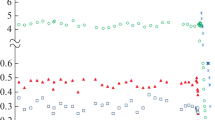Abstract
The vaporization of lithium pivalate (CH3)3CCOOLi (LiPiv) was studied by the Knudsen effusion method with the mass spectral analysis of the gas phase. The saturated vapor consisted of polynuclear molecules (LiPiv)n, dominated by (LiPiv)2 and (LiPiv)4 molecules. The absolute values of the partial pressures of these molecules and their dependence on temperature were calculated. The standard enthalpies of sublimation of the main components of the saturated vapor were determined to be \({{\Delta }_{s}}H_{{298}}^{^\circ }\)(LiPiv)2 = 174.2 ± 6.6 kJ/mol and \({{\Delta }_{s}}H_{{298}}^{^\circ }\)(LiPiv)4 = 195.7 ± 4.5 kJ/mol. The enthalpies of dissociation of the dimeric molecules into the monomeric molecules and of the tetrameric molecules into the dimeric molecules were calculated by the second and third laws of thermodynamics; the average values of these enthalpies are \({{\Delta }_{D}}H_{{298}}^{^\circ }\)(LiPiv)2 = 175.8 ± 13.5 kJ/mol and \({{\Delta }_{D}}H_{{298}}^{^\circ }\)(LiPiv)4 = 155.2 ± 10.0 kJ/mol. The standard enthalpies of formation of LiPiv in the condensed and gas phase were estimated from the known thermodynamic characteristics of lithium acetate and radicals of acetic and pivalic acids: \({{\Delta }_{f}}H_{{298.15}}^{^\circ }\)(LiPivsolid) ≤ –804 kJ/mol, \({{\Delta }_{f}}H_{{298.15}}^{^\circ }\)(LiPivgas) ≤ –627 kJ/kmol, \({{\Delta }_{f}}H_{{298.15}}^{^\circ }\)((LiPiv)2(gas)) ≤ –1430 kJ/mol, and \({{\Delta }_{f}}H_{{298.15}}^{^\circ }\)((LiPiv)4(gas)) ≤ –3017 kJ/mol.


Similar content being viewed by others
REFERENCES
N. J. Dudney, Interface (The Electrochemical Society) 17, 44 (2008).
H. Nishide and K. Oyaizu, Science 319, 737 (2008). https://doi.org/10.1126/1151831
W.-G. Choi and S.-G. Yoon, J. Power Sources 125, 236 (2004). https://doi.org/10.1016/j.jpowsour.2003.08.014
T. L. Kulova and A. M. Skundin, Elektrokhim. Energ. 9 (2), 57.
B. Wang, J. B. Bates, F. X. Hart, et al., J. Electrochem. Soc. 143, 3203 (1996). https://doi.org/10.1149/1.1837188
J. B. Bates, N. J. Dudney, B. J. Neudecker, et al., Solid State Ionics 135, 33 (2000). https://doi.org/10.1016/S0167-2738(00)00327-1
J. B. Bates, N. J. Dudney, B. J. Neudecker, et al., J. Electrochem. Soc. 147, 59 (2000). https://doi.org/10.1149/1.1393157
J. B. Bates, N. J. Dudney, G. R. Gruzalski, et al., J. Power Sources 43, 103 (1993). https://doi.org/10.1016/0378-7753(93)80106-Y
X. Yu, J. B. Bates, G. E. Jellison, et al., J. Electrochem. Soc. 144, 524 (1997). https://doi.org/10.1149/1.1837443
N. M. Khoretonenko, Candidate’s Dissertation in Chemistry (Moscow, 1998).
E. White V, Org. Mass Spectrom. 13, 495 (1978). https://doi.org/10.1002/oms.1210130903
K. Matsumoto, Y. Kosugi, M. Yanagisawa, et al., Org. Mass Spectrom. 15, 606 (1980). https://doi.org/10.1002/oms.1210151203
Y. Cao and K. L. Busch, J. Inorg. Chem. 33, 3970 (1994). https://doi.org/10.1021/ic00096a022
E. N. Zorina-Tikhonova, D. S. Yambulatov, M. A. Kiskin, et al., Russ. J. Coord. Chem. 46, 75 (2020). https://doi.org/10.1134/S1070328420020104
D. B. Kayumova, I. P. Malkerova, M. A. Shmelev, et al., Russ. J. Inorg. Chem. 64, 125 (2019). https://doi.org/10.1134/S0036023619010121
N. A. Gribchenkova and A. S. Alikhanyan, J. Alloys Compd. 778, 77 (2019). https://doi.org/10.1016/j.jallcom.2018.11.136
L. N. Gorokhov, Vestn. Mosk. Univ., Ser. Mat., Mekh., Astron., Fiz., Khim., p. 231 (1958).
L. N. Sidorov, M. V. Korobov, and L. V. Zhuravleva, Mass Spectral Thermodynamic Studies (MGU, Moscow, 1985) [in Russian].
J. W. Otvose and D. P. Stevenson, J. Am. Chem. Soc. 78, 546 (1956). https://doi.org/10.1021/ja01584a009
M. Guido and G. Gigli, High Temp. Sci. 7, 122 (1975).
R. T. Meyer and A. W. Lynch, High Temp. Sci. 5, 192 (1973).
Thermodynamic Properties of Individual Substances: Handbook (Nauka, Moscow, 1982), Vol. 4, Book 2 [in Russian].
N. V. Gogoleva, G. N. Kuznetsova, M. A. Shmelev, et al., J. Solid State Chem. 294, 121842 (2020). https://doi.org/10.1016/j.jssc.2020.121842
V. A. Lukyanova, T. S. Papina, K. V. Didenko, et al., J. Therm. Anal. Calorim. 92, 743 (2008). https://doi.org/10.1007/s10973-008-9019-x
L. A. Rudnitskii, Zh. Fiz. Khim. 35, 1853 (1961).
P. Gray and J. C. J. Thynne, Nature (Engl.), 191, 1357 (1961). https://doi.org/10.1038/1911357a0
F. J. Martínez Casado, M. Ramos Riesco, M. I. Redondo, et al., Cryst. Growth Des., 11, 1021 (2011).https://doi.org/10.1021/cg1010133
F. J. Martínez Casado, M. Ramos Riesco, M. V. Garcia Perez, et al., J. Phys. Chem. B 113, 12896 (2009). https://doi.org/10.1021/jp9047715
ACKNOWLEDGMENTS
The elemental analysis was performed using equipment of the Center for Common Use of Physical Methods of Investigation of Substances and Materials, Kurnakov Institute of General and Inorganic Chemistry, Russian Academy of Sciences, Moscow, Russia.
Funding
This work was supported under a state assignment for basic scientific research for the Kurnakov Institute of General and Inorganic Chemistry.
Author information
Authors and Affiliations
Corresponding author
Ethics declarations
The authors declare that they have no conflicts of interest.
Additional information
Translated by V. Glyanchenko
Rights and permissions
About this article
Cite this article
Kayumova, D.B., Malkerova, I.P., Kiskin, M.A. et al. Thermodynamic Characteristics of Lithium Pivalate according to High-Temperature Mass Spectrometry Data. Russ. J. Inorg. Chem. 66, 868–873 (2021). https://doi.org/10.1134/S0036023621060127
Received:
Revised:
Accepted:
Published:
Issue Date:
DOI: https://doi.org/10.1134/S0036023621060127




